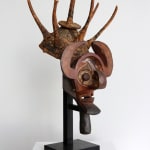Anonymous Yaka artist
Wood, pigments, fibers
height 18 7/8 in
Further images
Ndeemba Yaka masks are composed of a wooden human face featuring an elaborate fiber coiffure. These were danced by the newly initiated boys at the closing of the nkhanda initiation rituals, marking their transition to adult life. The masked dancers would wear a raffia netted shirt with sleeves and pants covering their whole body. The mask’s compact oval face itself was once almost completely hidden by fibers to hide the identity of the mask’s dancer. A handle at the chin of this mask would be held to secure the mask on the face during energetic dance performances. Unique visual elements (such as the pair of animal horns) were largely left to the sculptor and the expectations of the community. This zoomorphic feature likely refers to the masculinity that was expected from the newly initiated youth. The elongated and upturned nose on the mask alludes to notions of seduction and sexuality – subjects explored during the initiation period. Such an upturned nose is a common feature in much of the Yaka art and has been linked with an elephant’s trunk as a symbol of masculine power, an appropriate association for the occasion of circumcision. While such a nose is said to point to male fertility, the bulbous shape of the eyes is said to reference the moon and therefore female fertility. According to the Yaka specialist Arthur Bourgeois, this ndeemba mask can be identified as the nkaka type (“grandfather”), which is identified by the facial portion encircled in a frame (“Art of the Yaka and Suku”, Paris, 1984, p. 136, cat. 127). A cane frame covered in woven raffia cloth surmounts the wooden face. The raffia cloth suggests that this is an earlier example; raffia generally is thought to predate the use of cotton to conceal the armature. Resin was applied to the raffia and then painted in colorful geometric designs. The central spire on the fabricated portion of the coiffure commonly features a pompon of feathers (now lost). These coiffures appear to derive from traditional head pieces and hair styles formerly worn by Yaka notables. Once brightly painted, the mask still displays traces of its original polychromy. The refinement of the mask and the coiffure, and the balance of the complex composition testify of the archaicity of the present mask.
Provenance
Probably acquired from Hans Himmelheber, who travelled among the Yaka in 1938-39
Kunsthandel Matthias L.J. Lemaire, Amsterdam, The Netherlands, 1956
Harold & Florence Rome, NY, US, 1956-1987
Sotheby’s, New York, 20 May 1987, lot 137
Private Collection, US
Private Collection, Antwerp, Belgium, 2019
Christie’s, Paris, 10 April 2019, lot 121.
Private Collection, Belgium, 2019-2023
Exhibitions
“A New Selection of Tribal Art. The African Image”,
Toledo Museum of Art, Toledo, 1-22 February 1959
Publications
“A New Selection of Tribal Art. The African Image”, by Plass
(Margaret), The Toledo Museum of Art, Toledo, Ohio, USA, 1959, p. 28, #146
Gillon (Werner), “Collecting African Art”, London, 1979, p. 28, #24
let's keep in touch
Join our community & never miss out on a DUENDE moment from now on
* denotes required fields
We will process the personal data you have supplied to communicate with you in accordance with our Privacy Policy. You can unsubscribe or change your preferences at any time by clicking the link in our emails.













